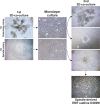Epithelial Plasticity During Human Breast Morphogenesis and Cancer Progression
- PMID: 27815674
- PMCID: PMC5159441
- DOI: 10.1007/s10911-016-9366-3
Epithelial Plasticity During Human Breast Morphogenesis and Cancer Progression
Abstract
Understanding the complex events leading to formation of an epithelial-based organ such as the breast requires a detailed insight into the crosstalk between epithelial and stromal compartments. These interactions occur both through heterotypic cellular interactions and between cells and matrix components. While in vivo models may partially capture these complex interactions, there is a need for in- vitro models to study these events. In this review we discuss cell-cell interactions in breast development focusing on the stem cell niche and branching morphogenesis. Given the recent understanding that the basic developmental events underlying branching morphogenesis are closely related to pathways important to cancer progression, i.e. epithelial plasticity and epithelial to mesenchymal transition (EMT), we will also discuss aspects relevant to cancer progression. In cancer, the adoption of mesenchymal phenotype by the malignant cells allows stromal invasion and subsequent intravasation to blood- or lymphatic vessels, a route that is a prerequisite for metastasis. A number of publications have demonstrated that tumor initiating cells, sometimes referred to as cancer stem cells adapt an EMT phenotype that renders them more resistant to apoptosis and drug therapy. The mechanism behind this phenomenon is currently unknown but this may partially explain relapse in breast cancer patients. Increased understanding of branching morphogenesis in the breast gland and the regulation of EMT and its reverse process mesenchymal to epithelial transition (MET) may hold the keys for future development of methods/drugs that neutralize the invading properties of cancer cells.
Keywords: 3D cell culture; Breast cancer; EMT; Plasticity; Stem cells.
Figures




References
Publication types
MeSH terms
LinkOut - more resources
Full Text Sources
Other Literature Sources
Medical
Miscellaneous

